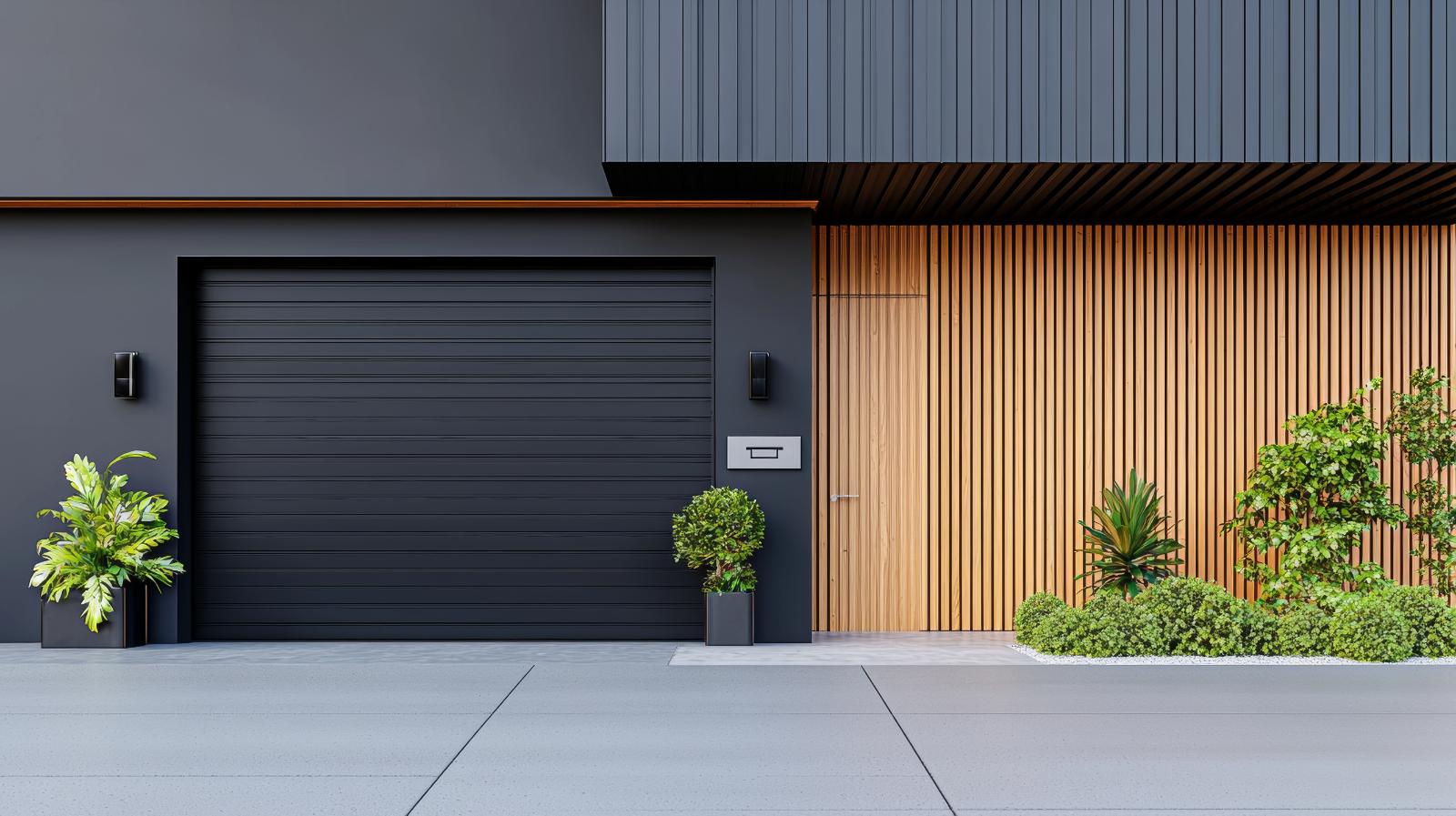
Contents
Your garage door opener plays an essential role in your home’s safety and convenience. If you’ve noticed it struggling to open or close smoothly, or if it’s making strange noises, it might be time for a replacement. Ignoring these signs can lead to bigger issues down the line. Understanding the benefits of upgrading and knowing what to look for can help you make the right decision. So, what should you consider when it’s time to replace your opener?
Key Takeaways
- Unusual noises or inconsistent operation indicate mechanical wear, signaling the need for replacement to prevent further issues.
- Upgrading to a newer model enhances convenience with smart technology and improved features.
- Newer openers offer better energy efficiency, reducing utility costs over time.
- Enhanced safety features in modern openers protect against accidents and injuries.
- Replacing an old opener ensures reliable performance, maintaining security and functionality for your home.
Signs Your Garage Door Opener Needs Replacement
When your garage door opener starts showing signs of wear, it can be tempting to ignore the problem, but doing so could lead to bigger issues down the line.
If you notice unusual noises like grinding or rattling, that’s a warning sign you shouldn’t overlook. These sounds often indicate mechanical wear or misalignment, which can compromise your opener’s functionality.
Inconsistent operation is another red flag—if your opener hesitates or fails to respond regularly, it’s likely time for a replacement. This inconsistency can’t only frustrate you but can also pose safety risks for your family and belongings.
Don’t wait for a complete breakdown before addressing these concerns. By recognizing these signs early, you’re not just protecting your garage door opener; you’re ensuring peace of mind and safety for your home.
Take action now, and you’ll foster a sense of security for everyone who relies on that garage door.
Choosing the Right Garage Door Opener
How do you choose the right garage door opener for your home? Start by considering your lifestyle and needs. If you value convenience, look for models that feature smart technology. These openers let you control your garage door from your smartphone, providing peace of mind and ease of access.
Next, think about energy efficiency. Many modern openers are designed to consume less power, which not only helps the environment but can also save you money on your utility bills.
Additionally, consider the type of drive system that suits your space: chain, belt, or screw drive. Each has its advantages, like noise level and durability.
Finally, don’t forget to check reviews and ask neighbors for recommendations. Choosing the right garage door opener can enhance your home’s functionality while making your life just a bit easier.
After all, you deserve a space that reflects comfort and security.
Safety Features to Consider
Choosing the right garage door opener isn’t just about convenience; safety features are equally important for protecting your home and loved ones.
When evaluating options, consider these essential safety features:
Safety Sensors: These detect objects in the door’s path, preventing accidents.
Smart Technology: Openers with smart capabilities allow you to monitor and control your garage door remotely, enhancing security.
Automatic Reverse: This feature automatically reverses the door if it encounters an obstruction, adding an extra layer of protection.
Manual Release: Verify your opener has a manual release option, allowing you to operate it even during power outages.
Types of Garage Door Openers
When it comes to garage door openers, you’ve got a few main types to choose from: chain drive, belt drive, and screw drive openers.
Each type has its own benefits and drawbacks, making it important to evaluate what fits your needs best.
Let’s break down these options so you can make an informed choice for your home.
Chain Drive Openers
Although many homeowners appreciate the reliability of chain drive openers, understanding their unique characteristics can help you decide if they’re the right fit for your garage.
These openers are known for their robust chain durability, making them a favorite for heavy doors. However, you should also consider their noise levels, as they tend to be louder than other options.
Here are some key points to keep in mind:
- Cost-effective: Generally, they’re more affordable than other types.
- Strength: Ideal for heavier garage doors due to their sturdy design.
- Maintenance: Requires regular lubrication to minimize noise.
- Lifespan: With proper care, they can last many years.
Ultimately, weigh these factors to find the opener that suits your needs best.
Belt Drive Openers
If you’re looking for a quieter and smoother operation for your garage door, belt drive openers might just be what you need.
These openers use a rubber belt instead of a chain, offering several belt drive advantages. You’ll enjoy minimal noise, which is perfect if your garage is attached to your home. Plus, the smooth operation reduces wear and tear on your door, enhancing its longevity.
Another key benefit is belt drive durability. These openers are built to last, often outlasting chain drives while requiring less maintenance.
With a belt drive opener, you not only elevate your home’s functionality but also contribute to a more peaceful environment. It’s a smart choice for anyone seeking reliability and quiet operation in their daily lives.
Screw Drive Openers
Screw drive openers offer a different approach to garage door operation, utilizing a threaded steel rod to lift and lower the door.
They’re known for their unique advantages and disadvantages, which can help you decide if they’re right for you.
Here are some screw drive advantages:
- Fewer moving parts, leading to less maintenance.
- Faster operation than some other types.
- Good for extreme temperatures since they perform well in various climates.
- Typically more affordable upfront costs.
However, consider these screw drive disadvantages:
- They can be noisier than belt drive models.
- Less effective for heavy doors.
- Sensitive to temperature changes, which might affect performance.
- Potential for wear on the threaded rod over time.
Tools Required for Replacement
Before you start replacing your garage door opener, it’s essential to gather the right tools.
You’ll need a solid checklist of vital tools, safety equipment, and installation gear to guarantee a smooth process.
Let’s break down what you’ll require for a successful replacement.
Essential Tools Checklist
Replacing your garage door opener can seem intimidating, but having the right tools at your fingertips makes the process much smoother.
To guarantee you’re well-prepared, here’s an essential tools checklist for your project. Keep your tools organized, so you can easily access them when needed.
- Drill – For securing brackets and mounting the opener.
- Screwdriver Set – You’ll need both flathead and Phillips to handle various screws.
- Wrenches – For tightening nuts and bolts securely.
- Ladder – Essential for reaching higher areas safely.
With these essential tools, you’ll feel more confident tackling the replacement, and you’ll be part of a community of DIY enthusiasts who take pride in their home improvements!
Safety Equipment Needed
When tackling a garage door opener replacement, having the right safety equipment is vital to guarantee your well-being.
First and foremost, invest in quality safety gear like goggles to protect your eyes from debris. A sturdy pair of protective gloves is important, too, as they’ll shield your hands from sharp edges and heavy components.
You might also want to keep a hard hat nearby if your workspace has overhead hazards. Additionally, a well-lit area is important, so consider using a flashlight or portable work light.
By equipping yourself with these essentials, you’ll not only enhance your safety but also guarantee a smoother, more efficient replacement process.
Installation Tools Overview
Having the right safety equipment is just the first step in your garage door opener replacement journey.
Understanding the installation basics includes knowing which tool types you’ll need. Here’s a handy list to get you started:
- Screwdriver Set: You’ll need both Phillips and flat-head screwdrivers for various screws.
- Wrench Set: Adjustable and socket wrenches help with bolts and nuts.
- Drill: A power drill speeds up the process, especially for mounting brackets.
- Level: Guarantees your new opener is perfectly aligned for peak performance.
With these tools on hand, you’ll be well-prepared to tackle your garage door opener replacement confidently.
Step-by-Step Replacement Process
A smooth and efficient garage door opener replacement can be achieved in just a few straightforward steps. Start by disconnecting the power and removing the old opener. Make sure you keep track of all the wiring connections, as these are essential for your new system.
Next, install the new opener following the manufacturer’s instructions, making certain everything aligns properly.
Once installed, reconnect the wiring connections carefully, verifying they match up as they did with the old unit. After that, it’s time to adjust the programming settings. Most openers require you to set limits for opening and closing, so take your time to get it right.
Finally, double-check everything is secure before powering it on. You’ll feel a sense of accomplishment as your new garage door opener operates smoothly, adding convenience and security to your home. Enjoy your enhanced garage experience!
Testing Your New Garage Door Opener
Testing your new garage door opener is essential to confirm it’s functioning properly and safely. You want to make sure your investment pays off and enhances your home’s convenience.
Here are some straightforward testing procedures to follow for a thorough performance evaluation:
Check the Remote: Test all remotes to ensure they operate the door smoothly from various distances.
Safety Sensors: Place an object in the door’s path to confirm the safety sensors reverse the door correctly.
Force Settings: Adjust the force settings to see if the door stops when it meets resistance.
Manual Operation: Disconnect the opener and manually lift the door to check for any stiffness or resistance.
Maintenance Tips for Longevity
Ensuring your garage door opener works well is just the beginning; regular maintenance is key to keeping it running smoothly for years.
To achieve this, establish a preventive maintenance routine that includes checking the hardware, like bolts and brackets, for signs of wear or damage.
Stick to a lubrication schedule, applying garage door lubricant to the opener’s chain, rollers, and hinges every six months. This simple step reduces friction and prolongs the life of your opener.
Don’t forget to inspect the safety sensors and test the door’s balance; a properly balanced door puts less strain on the opener.
Join a community of homeowners who prioritize maintenance, and you’ll find camaraderie in sharing tips and experiences.
Review
In conclusion, replacing your garage door opener isn’t just about convenience; it’s also about safety and efficiency. Did you know that nearly 30% of all home break-ins occur through the garage? Upgrading your opener can greatly enhance your home’s security, along with adding smart features that make your life easier. Don’t wait for a malfunction—take action now to guarantee your garage door operates smoothly and securely for years to come.
Recent Posts
3 Tips for Replacing Your Garage Door Opener
When it’s time to replace your garage door opener, you’ll want to make certain you’re
10 Best Steps for Replacing Your Garage Door Opener
Replacing your garage door opener is a task that can feel as intimidating as building
Unlocking Secrets: Mastering Overhead Door Installation
Did you know that nearly 70% of homeowners tackle overhead door installation themselves? This statistic

